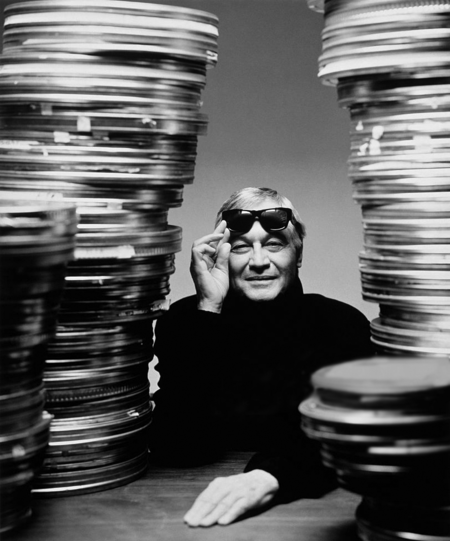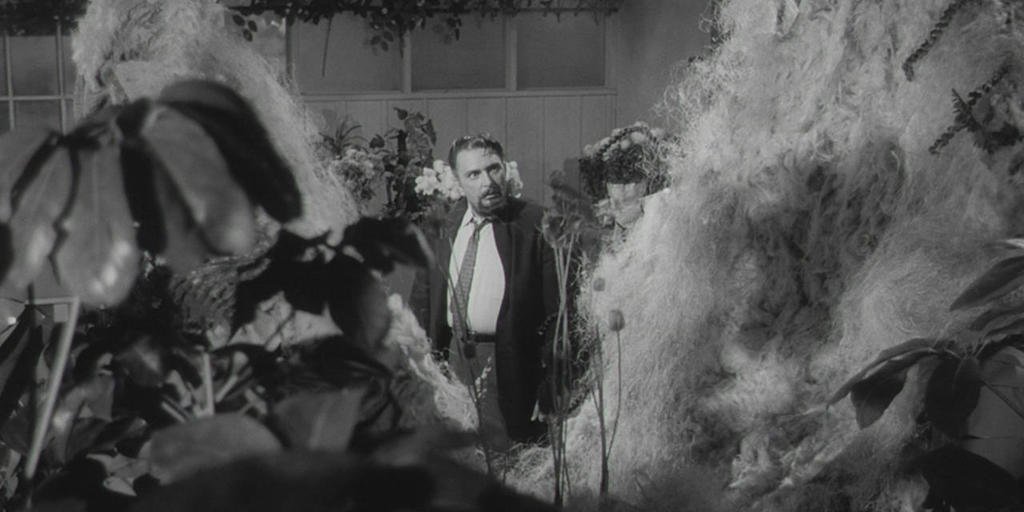The Cultural
Roger Corman, who just turned a distinguished ninety-six, produced over five hundred films and claims only one of them wasn’t profitable (The Intruder, for the record). As an honorary Oscar recipient, he is the dean of American indie genre cinema, yet he only has one film on the Library of Congress’s National Film Registry. Granted, he made a virtue out of “cheap and fast,” but the Film Registry mission is to preserve films of great cultural significance, rather than just critically acclaimed films. The truth is, Corman’s prolific productions have had an enormous cultural impact and deserve to be on the Registry, along with horror classics like Halloween (1978), Dracula (1931), and his own House of Usher (1960).
More than any other film, Little Shop of Horrors (streaming just about everywhere, including Shudder) made Corman’s fabled rep, through the tale of Audrey II, the mutant plant with a taste for human blood. As the story goes, after wrapping production on Bucket of Blood, Corman realized he still had access to the sets over the weekend, so he rushed a film into production before they were dismantled. Some say it was really more about other financial incentives, such as changing union rules, but the legend lives on.
In any event, Little Shop went on to have a life of its own, inspiring a hit musical adaptation that became a Hollywood movie in 1986. It finally reached Broadway in 2003 and was revived Off-Broadway just this year. Apart from its legacy, Little Shop is historic for a young Jack Nicholson making an early appearance as masochistic dental patient Wilbur Force. Plus, renown jazz cellist Fred Katz (who appears as part of Chico Hamilton’s combo seen in The Sweet Smell of Success) composed much of the score.
Bucket of Blood (streaming on Prime, etc.), the source of those infamous sets that were Little Shop’s reason-for-being, is also quite significant. It slyly and macabrely satirizes the beatnik scene, just after the Maynard G. Krebs character was introduced on the Dobie Gillis show and before MGM released its Jack Kerouac adaptation, The Subterraneans. Super-nebbish Walter Paisley is a talentless busboy, who is mistaken for a genius sculptor when he accidentally encases a cat in clay. Of course, to maintain his artistic reputation, he will need more bodies, inevitably escalating to people.
Bucket is one of the few starring roles for Corman fan-favorite Dick Miller (who was the subject of his own documentary, That Guy Dick Miller), but he frequently used the Paisley name in subsequent Corman movies. Like Little Shop after it, Bucket also featured music by Fred Katz, which would eventually start to sound familiar. Katz developed a reputation for re-selling the same score and cues to Corman, who either didn’t have time to notice or was too cheap to care.

Corman is celebrated for giving many young filmmakers their career breaks, including Francis Ford Coppola, who helmed Dementia 13 (Tubi, etc.) for Corman nine years before The Godfather was released. Knowing the Corman method, Coppola pitched his script as something they could film around the shooting schedule of Corman’s The Young Racers, utilizing the same sets.
You can tell Coppola had talent right from the start, because the black-and-white Dementia 13 is visually striking, especially for an early slasher film (predating Halloween and its imitators by about fifteen years). It actually feels more graphically violent than it really is, thanks to some strategic jump-cutting. Viewers can see how the editing tries to trick them, but it works anyway.
The Terror (Prime, etc.) was the rare instance of a Corman quickie that dragged on. Initially, Corman realized he still had the sets from his Poe film The Raven and co-star Boris Karloff for another two days. He started shooting without a script, expecting to fill in a story later.
However, various Corman proteges, including Coppola, Monte Hellman (Two-Lane Blacktop), and Jack Hill (the notorious Spider Baby) struggled to shape this project of “opportunity” into something remotely coherent over numerous subsequent shoots. Eventually, Jack Nicholson (playing the errant French officer who wanders across Karloff’s castle) would helm the final day of proper production. Yet, uncharacteristically, Corman returned to The Terror once more in 1990, to film wrap-around scenes with Dick Miller, which would allow him to file a copyright on the film, since his original 1963 cut had fallen into public domain. Despite being directed by committee and having a narrative that makes almost no sense, the weirdest thing about The Terror is that it somehow managed to achieve a heavy atmosphere of dread and decay.
Five years later, elements of The Terror also resurfaced in Peter Bogdanovich’s Targets (available on DVD), his first fully-credited feature directorial debut. In fact, incorporating scenes from the earlier film was the only stipulation Corman required of him. Ironically, Targets would be the most overtly political film Corman had produced since The Intruder, his only money-loser.
With a split, socially-conscious narrative that anticipates films like Crash, Target follows aging horror icon Byron Orlok, on the verge of retirement, and Bobby Thompson, a Vietnam veteran, who is about to launch a shooting spree. Targets was transparently based on the 1966 University of Texas shootings, but it had a pseudo-meta dimension, before meta was a thing. Not only does Karloff play Orlok (who supposedly starred in The Terror) but Bogdanovich also portrays young Sammy Michaels, an aspiring director, who has finally written Orlok a good script. Unfortunately, the aging actor believes his old-fashioned style of horror has been rendered obsolete by more graphic contemporary films and the violent real-life events of the 1960s, a judgement that will be tragically vindicated when the film brings Orlok and Thompson together for a anxious climax in a crowded drive-in.
The sniper scenes in Targets are intense and horrific. Arguably, it is just as much a horror film as Ryuhei Kitamura’s Downrange, while the Orlok storyline is definitely “horror-adjacent.” In fact, Orlok represents a synthesis of Karloff’s more grandfatherly later roles (he was the voice of the Grinch after all) and his classic horror work. In the documentary Boris Karloff: The Man Behind the Monster, Bogdanovich (who just passed away in January) recalls how the cast and crew of Targets burst into spontaneous applause after Karloff finished his “Appointment in Samarra” monologue. It is a great scene and a great performance. Karloff made a handful of films after Targets, but it arguably represents a summation of his career.
There is no question Corman had an eye for promising young filmmakers and he definitely helped shaped American film culture. Mystery Science Theater 3000 would have been much poorer without his filmography. Except for The Terror, you can rest assured all of the above films came in on-time and under-budget. Horror fans wouldn’t want to imagine a world without him, so if you are so inclined, you can nominate the above films (or any other of your horror favorites) for the National Film Registry here.



